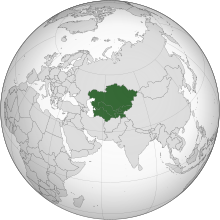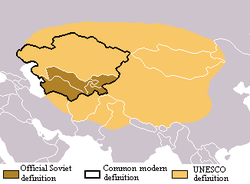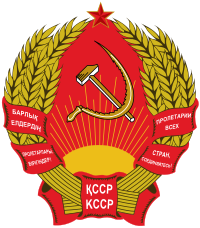Soviet Central Asia
 | |
| Area | 4,003,451 km2 (1,545,741 sq mi) |
|---|---|
| Demonym | Central Asian, Soviet |
| Countries | |
| Languages | Karakalpak, Kazakh, Kyrgyz, Russian, Tajik, Turkmen, Uzbek, and Others |
| Time zones | 2 time zones
|
| Internet TLD | .su, .kg, .kz, .tj, .tm, .uz |
| Calling code | Zone 9 except Kazakhstan (Zone 7) |
| Largest cities | |
| UN M49 code | 143 – Central Asia142 – Asia001 – World |
| |

Soviet Central Asia (Russian: Советская Средняя Азия, tr. Sovetskaya Srednyaya Aziya) was the part of Central Asia administered by the Soviet Union between 1918 and 1991, when the Central Asian republics declared independence. It is nearly synonymous with Russian Turkestan in the Russian Empire. Soviet Central Asia went through many territorial divisions before the current borders were created in the 1920s and 1930s.
Administrative divisions
Former divisions
Turkestan Autonomous Soviet Socialist Republic

By the end of the 19th century, Russian tsars effectively ruled over most of the territory that later would constitute Soviet Central Asia. Russia annexed Lake Issyk Kul in north east Kyrgyzstan from China in the early 1860s, lands of Turkmens, Khanate of Khiva, Emirate of Bukhara in the second half of 1800s.
Emerging from the Russian Empire following the Russian Revolution of 1917 and the Russian Civil War of 1918–1921, the USSR was a union of several Soviet republics, but the synecdoche Russia – after its largest and dominant constituent state – continued to be commonly used throughout the state's existence. Turkestan Autonomous Soviet Socialist Republic (initially Turkestan Socialist Federative Republic) (30 April 1918 – 27 October 1924) was created from the
British and Persian forces briefly tried to reach
would see various anti-Bolshevik risings over the next few years.In 1924, it was split into Karakalpak Autonomous Oblast (now Karakalpakstan), Kara-Kirghiz Autonomous Oblast (now Kyrgyzstan), Tajik ASSR (now Tajikistan), Turkmen SSR (now Turkmenistan), and Uzbek SSR (now Uzbekistan).
Bukharan People's Soviet Republic

In March 1918, activists of the Young Bukharian Movement informed the Bolsheviks that the Bukharans were ready for the revolution and that the people were awaiting liberation. The Red Army marched to the gates of Bukhara and demanded that the emir surrender the city to the Young Bukharans. As Russian sources report, the emir responded by murdering the Bolshevik delegation, along with several hundred Russian inhabitants of Bukhara and the surrounding territories. The majority of Bukharans did not support an invasion and the ill-equipped and ill-disciplined Bolshevik army fled back to the Soviet stronghold at Tashkent.
However, the emir had won only a temporary respite. As the civil war in Russia wound down, Moscow sent reinforcements to Central Asia. On 2 September 1920, an army of well-disciplined and well equipped Red Army troops under the command of Bolshevik general
, Afghanistan.A nearby anti-Bolshevik stronghold in the Tadjik/Moslem village of Khangir (qingir) declared its independence shortly afterwards, but soon surrendered after a 14-day siege by Russian and Bokhkori Bolsheviks. It was then quickly re-integrated back into Communist Bokhorah.
The Bukharan People's Republic was proclaimed on 8 October 1920 under
Prior to the establishment of the state of Israel, the
Khorezm People's Soviet Republic and SSR

The Khorezm People's Soviet Republic was created as the successor to the Khanate of Khiva in February 1920 and officially declared on 26 April 1920. On 20 October 1923, it was transformed into the Khorezm Socialist Soviet Republic. The Khorezm SSR only survived until 17 February 1925, when it was divided between Karakalpak Autonomous Oblast, the Turkmen SSR, and the Uzbek SSR as part of the reorganization of Central Asia by Moscow according to nationalities.
Kara-Kirghiz Autonomous Oblast
The Kara-Kyrgyz Autonomous Oblast (Кара-Киргизская АО) was created on 14 October 1924 within the Russian SFSR from the predominantly Kazakh and Kyrgyz parts of the Turkestan Autonomous Soviet Socialist Republic. On 15 May 1925 it was renamed into the Kyrgyz Autonomous Oblast. On 11 February 1926 it was reorganized into the Kyrgyz ASSR. On 5 December 1936 it became the Kyrgyz SSR, one of the constituent republics of the Soviet Union.
Karakalpak Autonomous Oblast
The Karakalpak Autonomous Oblast was created on 19 February 1925 by separating lands of the ethnic Karakalpaks from the Turkestan Autonomous Soviet Socialist Republic and Khorezm People's Soviet Republic.
Initially located within the Kazakh Autonomous Socialist Soviet Republic, the Karakalpak A.O. was transferred to the RSFSR from 20 July 1930 to 20 March 1932, at which time it was elevated to the Karakalpak Autonomous Soviet Socialist Republic. The Karakalpak ASSR was joined to the Uzbek SSR on 5 December 1936.
Kazakh Autonomous Soviet Socialist Republic
The Kazakh ASSR was an autonomous republic of the Soviet Union. It became the Kazakh SSR on 5 December 1936.
Its original name was the Kirgiz Autonomous Soviet Socialist Republic. This ASSR was established on 26 August 1920, and was a part of the Russian Soviet Federative Socialist Republic (RSFSR)
In 1925 it was renamed the Kazakh Autonomous Soviet Socialist Republic. In 1929 the city of Almaty (Alma-Ata) was designated as the capital of the ASSR.
Soviet Republics
Kazakhstan
The
In 1924, the borders of political units in Central Asia were changed along ethnic lines determined by Lenin's Commissar for Nationalities, Joseph Stalin. The Turkestan ASSR, the Bukharan People's Republic, and the Khorezm People's Republic were abolished and their territories were divided into eventually five separate Soviet Socialist Republics, one of which was the Uzbek Soviet Socialist Republic. The next year the Uzbek SSR became one of the republics of the Soviet Union.
Kyzil Orda / Kyzylorda was founded in 1820 as a Kokand fortress of Ak-Mechet (also spelt Aq Masjid, Aq Mechet, 'white mosque'). The name comes from the Kazakh for 'Red center'.
Uralsk / Oral was founded in 1613 by Cossacks, was originally named Yaitsk, after the Yaik River. The city was put under siege during the Russian Civil War. It has a population of 210,600. It is the capital of the West Kazakhstan Province. Ethnic composition is dominated by Russians (54%), Kazakhs (34%), along with a few Ukrainians and Germans.
Kirghizia
The
On 5 December 1936, it became a separate constituent republic of the USSR as the Kyrgyz Soviet Socialist Republic during the final stages of the national delimitation in the Soviet Union.
Tajikistan
The Tajik Soviet Socialist Republic, also named Tajikistan (or by its Russian spelling, Tadzhikistan), was one of the new states created in Central Asia in 1924 was Uzbekistan, which had the status of a Soviet socialist republic. In 1929 Tajikistan was detached from Uzbekistan and given full status as a Soviet socialist republic. The city of Dushanbe would become an important regional hub on the border with Afghanistan.
Tajikistan has 3
In 1931, the city formerly known as "Dyushambe" was renamed "Stalinabad" (after Joseph Stalin), but in 1961, as part of
Turkmenia
The
The
Uzbekistan
The
The Uzbek SSR included the Tajik ASSR until 1929, when the Tajik ASSR was upgraded to an equal status. In 1930, the Uzbek SSR capital was relocated from
The State Anthem of the Uzbek SSR was the
The city of
As the nation's capital, Tashkent is still a fairly prosperous city and the capital of Uzbekistan and has a population of the city in 2006 was 2.1 million. The city has been the target of several terrorist acts since gaining independence. These have been attributed by the Uzbek the government to Islamic insurgents aided by the Afghan Taliban.
Nationalist rebellions
Turkestan Autonomy

Kokand is a city in
Kokand is on the crossroads of the ancient trade routes, at the junction of two main routes into the Fergana Valley, one leading northwest over the mountains to Tashkent, and the other west through Khujand. As a result, Kokand is the main transportation junction in the Fergana Valley.
Russian imperial forces under
Alash Autonomy

The Alash Autonomy (
The Alash Orda (
The Alash Party proclaimed the autonomy of the Kazakh people in December 1917. Membership consists from 25 members (10 positions reserved for non-Kazakhs) and 15 member candidates. They formed special educational commission and established militia regiments as their armed forces.

Basmachi revolt
In 1897, the railway reached
Kengir uprising
During the rule of Joseph Stalin, a prison labour camp of the Steplag division of the Gulag was set up adjacent to the village of Kengir, near the River Kengir in central Kazakhstan. It was mentioned in Aleksandr Solzhenitsyn's book, The Gulag Archipelago. The location of the camp was near the city of Dzhezkazgan. Russian actor Oleg Yankovsky is the most famous of the city's natives. There was a prison revolt in 1954, by political prisoners, criminals, and other inmates.
Exiles
Dissident Islamist and anti-Soviet Central Asians fled to Afghanistan, British India, and to the Hijaz in Saudi Arabia.
Uzbek exiles in Saudi Arabia from Soviet ruled Central Asia also adopted the identity "Turkistani".[8][9] A lot of them are also called "Bukhari".[10][11] A number of Saudi "Uzbeks" do not consider themselves as Uzbek and instead consider themselves as Muslim Turkestanis.[12] Many Uzbeks in Saudi Arabia adopted the Arabic nisba of their home city in Uzbekistan, such as Al Bukhari from Bukhara, Al Samarqandi from Samarqand, Al Tashkandi from Tashkent, Al Andijani from Andijan, Al Kokandi from Kokand, Al Turkistani from Turkistan.
Bukhari and Turkistani were labels for all the Uzbeks in general while specific names for Uzbeks from different places were Farghani, Marghilani, Namangani, and Kokandi.[13][14] Kokandi was used to refer to Uzbeks from Ferghana.[15]
Shami Domullah introduced Salafism to Soviet Central Asia.[16][17]
Mosques in Uzbekistan are funded by Saudi-based Uzbeks.[18]
Saudis have tried to propagate their version of Islam into Uzbekistan following the collapse of the Soviet Union.[19][20][21][22]
Saudi Arabia's "Bukharian brethren" were led by Nuriddin al-Bukhari as of 1990.[23]
Industry

Oil and gas
After
The central part of the
Kazakhstan's
From 1964 to 1991 Aktau, which had become a city, bore the name "Shevchenko" in honour of the Ukrainian poet Taras Shevchenko (1814–1861), who had been assigned to the area on military[citation needed] work. The average temperature on January is −3 °C, on July +26 °C. Annual rainfall averages 150 mm. Aktau had a population of 154,500 as of 2004[update].
Transport
Much of the road and railway infrastructure that exists across Central Asia was developed when the areas was in the Soviet Union. As a result, it often disregards existing national borders. After the dissolution of the Soviet Union, this infrastructure has faced decline and degradation.[25]
Metallurgy

Kazakhstan had started to produce and refine sizable amounts of tin and uranium by the early 1970s. Vanadium and cobalt were, and still are also mined in the south of the country. Uranium was also first produced in Uzbekistan in the 1970s.
The city of
Its urban area includes the neighbouring mining town of
Today the city is the headquarters of the copper conglomerate Kazakhmys, the city's main employer. The company has subsidiaries in China, Russia, France and the UK and is listed on the London Stock Exchange.
Cement
Cement was a major product in both the cities of Shymkent and Dushanbe in the south of the region.
Hydro-electricity
By the early 1970s, the Soviets had started to build some of their
Cotton
The Soviets began to grow cotton in Uzbekistan after the
Baikonur Cosmodrome
The
On 8 June 2005 the
Culture, religion and ethnicity

Following a series of migrations, mostly predating Soviet rule, that displaced the autochthonous
In Kazakh [qɑzɑqtɑr]; Russian: Казахи; the English name 'Kazakh' is transliterated from Russian) are
According to Robert G. Gordon, Jr., editor of the Ethnologue: Languages of the World, classifies
The Slavic community would grow very rapidly under communism and Russians would eventually become a major ethnic group in the region. The
Religion
The Bolsheviks would quickly set about closing mosques and churches throughout the USSR. This became particularly prevalent in the 1930s, but had been fully abandoned by the 1980s. (No Citation)
Veil
In Uzbekistan and Tajikistan women wore veils which covered their entire face and body like the Paranja and faranji.
The traditional veil in Central Asia worn before modern times was the faranji but it was banned by the Soviet Communists.[26][27]
Y-haplogroups
According to the interim results of Kazach mitochondrial DNA studies
The on a similar level, the distribution of Y-DNA haplogroups, according to E.K. Husnutdinova,
R1a
The descent of the Kyrgyz from the
R-Z93 (R1a1a1b2)
This large subclade appears to encompass most of the R1a1a found in Asia (Pamjav 2012).
See also
- Hujum
- Bamboo Curtain
- Russian Turkestan
- Soviet–Afghan War
References
- ^ "Central Asia" (PDF). U.S. ONLINE TRAINING FOR OSCE.
- ^ (in Russian) С начала года население Алматы увеличилось на 1,4% Gazeta.kz
- ^ Leftist Parties of Turkmenistan Archived 22 July 2012 at the Wayback Machine Leftist Parties of the World
- ^ http://carnegieendowment.org/files/cp_77_olcott_roots_final.pdf http://carnegieendowment.org/files/olcottroots.pdf page 8
- ^ https://www.worldwatchmonitor.org/research/reportcentralasiaislamicextremism.pdf page 7
- ^ "قاسم بن عبد الجبار الأنديجاني - أعلام وشخصيات".
- ^ "(منبع العرفان) تفسير كبير باللغة الأوزبكية (القديمة) بالحرف العربي - ملتقى أهل التفسير".
- ISBN 978-91-86884-16-1.
- ^ "Archived copy" (PDF). Archived from the original (PDF) on 4 March 2016. Retrieved 3 November 2015.
{{cite web}}: CS1 maint: archived copy as title (link) - ISBN 978-0-313-34442-8.
- ^ http://archive.aawsat.com/details.asp?section=43&article=473739&issueno=10783 https://bukhariyon.files.wordpress.com/2009/09/22042009.jpg?w=765 https://bukhariyon.files.wordpress.com/2009/09/n873330654_6177366_2107662.jpg?w=450&h=338 https://bukhariyon.files.wordpress.com/2009/09/4491_110812876759_697671759_3186263_7497572_n.jpg?w=338&h=450 https://bukhariyon.files.wordpress.com/2009/09/n629897282_964239_5928.jpg?w=450&h=338 https://bukhariyon.files.wordpress.com/2009/09/n615363233_1080293_6221.jpg?w=450&h=338 https://bukhariyon.wordpress.com/2009/09/20/%D8%A7%D9%84%D8%A8%D8%AE%D8%A7%D8%B1%D9%8A%D9%88%D9%86-%D9%85%D9%86-%D9%87%D9%85%D8%9F/ https://bukhariyon.wordpress.com/2009/09/20/البخاريون-من-هم؟/ http://www.turkistanweb.com/?p=2156 Archived 2 April 2016 at the Wayback Machine http://turkistan.ahlamontada.com/t202-topic https://twitter.com/Abunass3r/status/726845854896820225
- ISBN 978-91-86884-16-1.
- ^ https://cess.memberclicks.net/assets/cesr2/CESR3/article%203%20v3n1.pdf Archived 4 March 2016 at the Wayback Machine page 16
- ^ Cutler, Robert M. "The Complexity of Central Eurasia". p. 16.
- ISBN 978-1-349-40743-9.
- ^ "Special: Dangerous Preaching: The Role of Religious Leaders in the Rise of Radical Islam in Central Asia. By Nurbek Bekmurzaev". Archived from the original on 4 March 2016. Retrieved 3 November 2015.
- ISBN 978-1-134-20731-2.
- ^ "The Myth of Militant Islam: Uzbekistan". 29 December 1995.
- ^ "CA&C; Press AB". Archived from the original on 25 June 2020. Retrieved 3 November 2015.
- ^ https://www.ucis.pitt.edu/nceeer/2007_819-01g_Collins.pdf page 16
- ^ Kalra, Prajakti. "Hidden Linkages: The Republic of Uzbekistan and the Gulf Region in Changing World Order".
- ISBN 978-1-135-97169-4.
- ^ Central Asian Studies Association (1990). Central Asia File: Newsletter of the Central Asian Studies Association. School of Oriental and African Studies, University of London. p. 20.
- ^ Petroleum Potential of Fergana Intermontane Depression Internet Geology Newsletter
- ^ "Central Asia: Decay and Decline". International Crisis Group. Archived from the original on 5 April 2013. Retrieved 17 April 2013.
- ISBN 978-0-8108-6061-2.
- ^ Pannier, Bruce (1 April 2015). "Central Asia's Controversial Fashion Statements". Radio Free Europe Radio Liberty.
- ^ Березина, Г. М.; Святова, Г. С.; Абдуллаева, A. M.; Бермишева, М. А.; Кутуев, И. А.; Хуснутдинова, Э. К.; Виллемс, Р. (2005). "Полиморфизм митохондриальной ДНК в казахской популяции". Медицинская Генетика. 4 (3).
- ^ 10_1
- H. B. Paksoy (1989). Alpamysh: Central Asian Identity Under Russian Rule. AACAR. ISBN 978-0-9621379-9-0.
- Pamjav (December 2012), "Brief communication: New Y-chromosome binary markers improve phylogenetic resolution within haplogroup R1a1", American Journal of Physical Anthropology, 149 (4): 611–615, PMID 23115110
 This article incorporates text from this source, which is in the public domain. Country Studies. Federal Research Division.
This article incorporates text from this source, which is in the public domain. Country Studies. Federal Research Division.
Further reading
External links
- The Strange State of Soviet Central Asia Alicia Patterson Foundation Reporter
- Keller, Bill (1989). "Afghan Cadets Reportedly Riot in a Capital in Soviet Central Asia", The New York Times.
- Kazakh SSR Anthem YouTube
- Uzbek SSR Anthem YouTube
- Soviet Language Policy in Central Asia by Mark Dickens Archived 7 June 2011 at the Wayback Machine
- Hierman, Brent (20 January 2016). "Citizenship in Soviet Uzbekistan". Dissertation Reviews.
- Akyildiz, Sevket Akyildiz; Carlson, Richard, eds. (2014). Social and Cultural Change in Central Asia: The Soviet Legacy. Routledge. ISBN 978-0-415-70453-3.
- Alec Rasizade. Dictators, Islamists, big powers and ordinary people: the new ‘great game’ in Central Asia. = Internationale Politik und Gesellschaft (Bonn: F.Ebert Stiftung), July 2002, number 3, pages 90–106.










